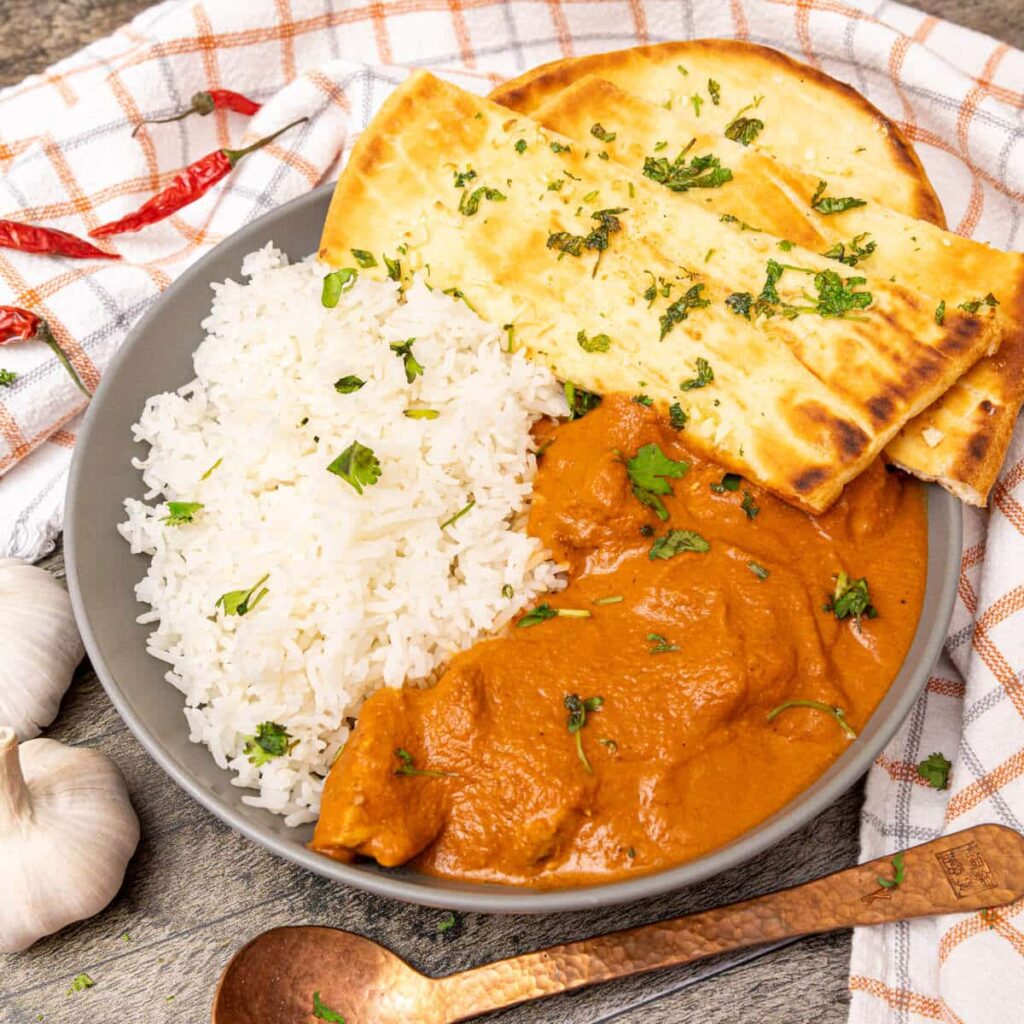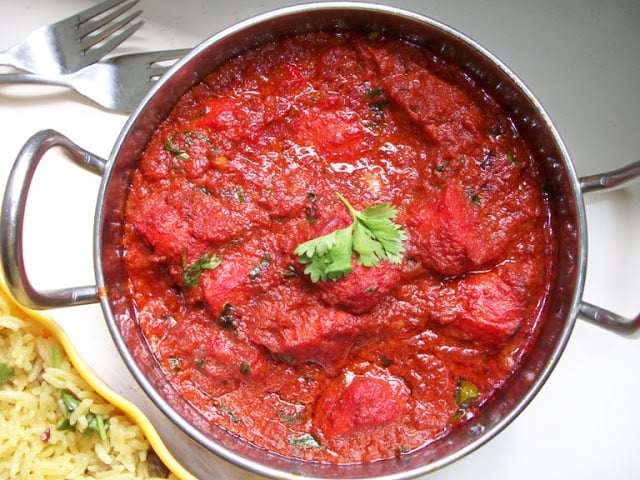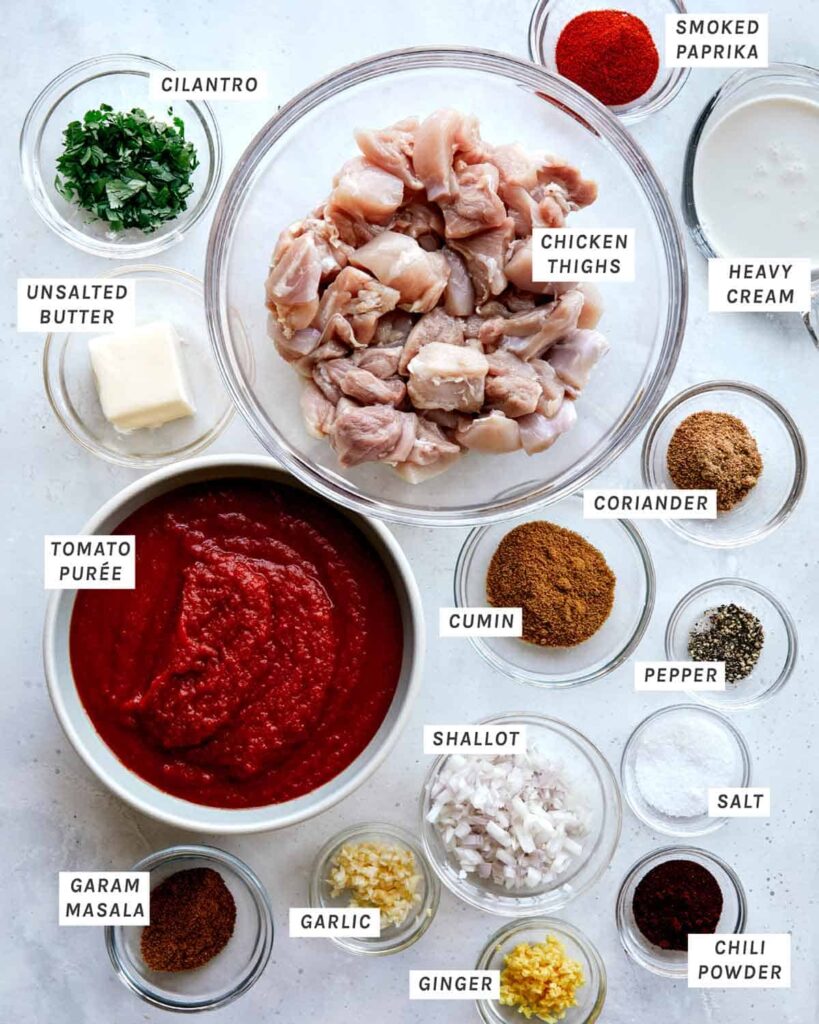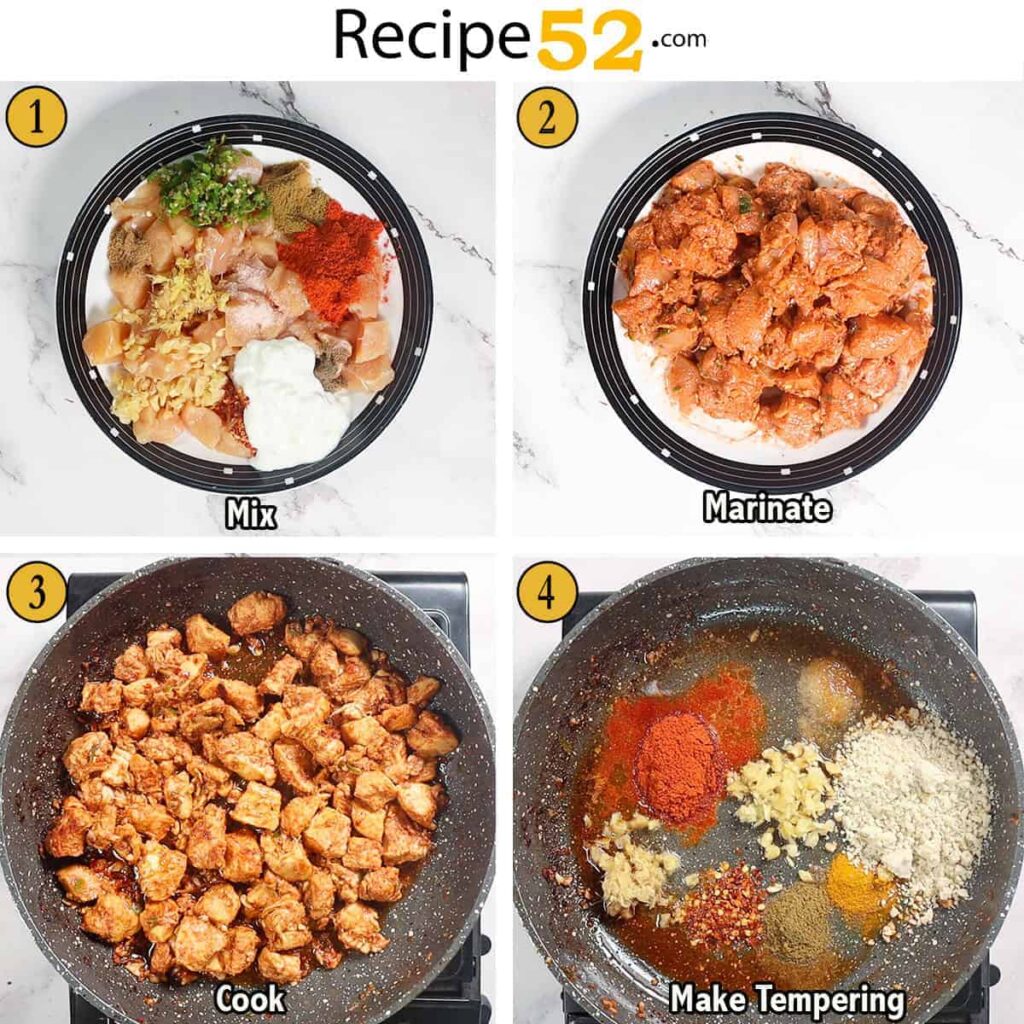Chicken tikka masala is a dish that captures the heart of Indian cuisine with its bold spices, creamy tomato sauce, and tender, charred chicken. Often hailed as Britain’s unofficial national dish, this vibrant curry is a global favorite, blending smoky tandoori flavors with a rich, comforting sauce. Whether you’re craving a cozy weeknight meal or aiming to impress at a dinner party, homemade chicken tikka masala delivers an unforgettable culinary experience.
In this ultimate guide, we’ll uncover everything you need to master chicken tikka masala at home. From its fascinating origins to a detailed recipe, nutritional insights, and creative variations, this article is your go-to resource. Chicken Tikka Masala With step-by-step instructions, expert tips, and pairing suggestions, you’ll create a restaurant-quality dish that rivals your favorite takeout. Chicken Tikka Masala We’ll also address common pitfalls and offer links to complementary recipes and resources.

For more Indian-inspired dishes, explore our Vegetarian Butter Chicken or Homemade Naan Bread. For a deeper dive into Indian cuisine, check out Wikipedia’s page on TASTETROVE.
The Captivating History of Chicken Tikka Masala
Chicken tikka masala’s origins are as vibrant as its flavors, though its exact birthplace is debated. Most food historians trace it to the United Kingdom in the mid-20th century, likely in the 1960s or 1970s, when South Asian immigrants adapted Indian recipes for British palates. One popular story credits a Glasgow restaurant, Shish Mahal, where a customer reportedly complained that their chicken tikka was too dry. The chef improvised, creating a creamy tomato-based sauce with spices, yogurt, and possibly canned tomato soup, birthing the iconic dish.
The term “tikka” comes from the Hindi word for small chunks of meat, traditionally marinated and cooked in a tandoor, a clay oven used in North Indian cuisine. “Masala” refers to the spice blend that defines the sauce’s complexity. While rooted in Indian techniques, chicken tikka masala is a fusion dish, reflecting the cultural exchange between India and Britain. Some argue it draws inspiration from butter chicken (murgh makhana), a Delhi creation from the 1950s, but its unique flavor profile sets it apart.
By the 1990s, chicken tikka masala had become a staple in British curry houses and spread globally, symbolizing the diaspora’s culinary influence. In 2001, British Foreign Secretary Robin Cook famously called it “a true British national dish,” highlighting its cultural significance. Today, it’s beloved worldwide, from Indian restaurants to home kitchens.
For more on Indian culinary history, visit our History of Indian Spices or read BBC Good Food’s take on its origins.
Nutritional Benefits: A Balanced and Flavorful Dish
Chicken tikka masala isn’t just a flavor bomb—it’s surprisingly nutritious when prepared thoughtfully. The dish combines lean protein, vegetables, and spices with health benefits, making it a satisfying meal that can fit into a balanced diet.
Chicken breast, the star ingredient, is a lean protein source, providing about 26 grams of protein per 3-ounce serving, essential for muscle repair and satiety. Chicken Tikka Masala Yogurt in the marinade adds probiotics for gut health and calcium for bones. Tomatoes, the base of the sauce, are rich in lycopene, an antioxidant linked to heart health and cancer prevention.

Spices like turmeric, cumin, and coriander offer anti-inflammatory and antioxidant properties. Turmeric’s curcumin may reduce inflammation, while cumin supports digestion. Garlic and ginger, common in the marinade and sauce, boost immunity and aid digestion. A typical serving (about 1.5 cups) ranges from 400-600 calories, depending on cream or coconut milk usage, making it filling yet manageable.
To lighten it up, use low-fat yogurt or coconut milk and serve with brown rice or quinoa for added fiber. For more on healthy cooking, Chicken Tikka Masala check our Guide to Balanced Meals or Healthline’s spice benefits.
Essential Ingredients for Authentic Chicken Tikka Masala
Quality ingredients are the backbone of a stellar chicken tikka masala. Here’s what you need for 4 servings:
| Ingredient | Quantity | Notes |
|---|---|---|
| Boneless, skinless chicken breast | 1.5 lbs. | Cut into 1-inch cubes; thighs work for richer flavor. |
| Plain yogurt | 1 cup | Full-fat for best margination. |
| Lemon juice | 2 tbsp.. | Freshly squeezed for brightness. |
| Garlic | 4 cloves, minced | For marinade and sauce. |
| Ginger | 1-inch piece, grated | Fresh for warmth and depth. |
| Ground cumin | 2 tsp | For earthy flavor. |
| Ground coriander | 2 tsp | Adds citrusy notes. |
| Turmeric | 1 tsp | For color and health benefits. |
| Garam masala | 2 tsp | Key spice blend; check our Garam Masala Recipe. |
| Paprika or Kashmiri chili powder | 1 tsp | For color and mild heat. |
| Tomato puree | 1.5 cups | Canned or fresh for rich sauce. |
| Heavy cream or coconut milk | 1 cup | Cream for richness, coconut milk for dairy-free. |
| Onion | 1 large, finely chopped | Base for sauce. |
| Butter or ghee | 2 tbsp. | For sautéing and flavor. |
| Fresh cilantro | 1/4 cup, chopped | For garnish. |
| Salt | To taste | Enhances all flavors. |
| Vegetable oil | 2 tbsp. | For grilling or sautéing chicken. |
These create a gluten-free dish, easily dairy-free with coconut milk. Source fresh spices from local markets or online for maximum flavor. See Serious Eats’ Chicken Tikka Masala for ingredient tips.

Step-by-Step: Crafting the Perfect Chicken Tikka Masala
This recipe takes about 1 hour (plus marinating time) and serves 4. A grill or oven broiler mimics the tandoor’s char.
- Marinate the Chicken: In a bowl, mix 1 cup yogurt, 2 tbsp lemon juice, 2 minced garlic cloves, 1 tsp grated ginger, 1 tsp cumin, 1 tsp coriander, 1 tsp turmeric, 1 tsp garam masala, 1 tsp paprika, and 1 tsp salt. Add 1.5 lbs. chicken cubes, coat well, and marinate in the fridge for at least 1 hour, preferably overnight.
- Prepare the Chicken: Thread chicken onto skewers. Grill over medium-high heat (or broil on a baking sheet) for 8-10 minutes, turning once, until lightly charred and cooked through. Set aside.
- Make the Sauce Base: In a large skillet, heat 2 tbsp butter and 1 tbsp oil over medium. Add 1 chopped onion and cook until golden, about 8 minutes. Stir in 2 minced garlic cloves and 1 tsp grated ginger for 1 minute.
- Build the Sauce: Add 1 tsp cumin, 1 tsp coriander, 1 tsp garam masala, and 1/2 tsp paprika. Cook for 1 minute. Stir in 1.5 cups tomato puree and simmer for 10 minutes until thickened.
- Finish the Sauce: Add 1 cup cream or coconut milk, stirring until smooth. Simmer 5 minutes. Add grilled chicken and cook 5-7 minutes to meld flavors. Adjust salt.
- Garnish and Serve: Stir in 2 tbsp cilantro. Serve hot with rice or naan, garnished with extra cilantro.
For visuals, see RecipeTin Eats’ Chicken Tikka Masala.
8 Expert Secrets for a Show-Stopping Chicken Tikka Masala
- Marinate Longer: Overnight marination tenderizes chicken and deepens flavor.
- Char for Authenticity: Grilling or broiling mimics tandoor smokiness.
- Toast Spices: Bloom spices in hot oil to unlock their aroma.
- Balance Heat: Adjust chili powder for your spice tolerance.
- Use Fresh Ginger: Powdered ginger lacks the same punch.
- Thicken Sauce Naturally: Simmer to reduce tomato puree instead of adding thickeners.
- Store Properly: Refrigerate for 3 days; freeze for 2 months. Reheat with a splash of water.
- Dairy-Free Swap: Coconut milk maintains creaminess without dairy.
Explore our Indian Cooking Tips or The Spruce Eats’ recipe.
Creative Variations to Spice Up Your Tikka Masala
Chicken tikka masala is versatile. Try these twists:
- Vegetarian: Swap chicken for paneer or tofu. See our Paneer Tikka Masala.
- Spicy Kick: Add fresh chilies or cayenne for heat.
- Vegan: Use coconut yogurt and milk with chickpeas.
- Instant Pot: Marinate, sauté, and pressure cook for 8 minutes.
Check Bon Appétit’s variations or our Vegan Indian Recipes.

Perfect Pairings: Drinks, Sides, and Serving Ideas
Pair with a crisp lager like Kingfisher or a fruity white like Riesling to balance spices. For reds, try a light Pinot Noir. Serve with basmati rice, naan, or cucumber raita to cool the palate. Mango lassi or gulab jamun makes a sweet finish. See Food & Wine’s curry pairings or our Indian Meal Planning.
FAQs: Your Chicken Tikka Masala Questions Answered
Can I skip marinating?
Since your question about skipping marination likely refers to the butter chicken recipe provided earlier, I’ll address it in that context. However, if you meant a different recipe, please clarify, and I can tailor the response.
You can skip marinating the chicken in Chicken Tikka Masala, but it’s not recommended as it significantly impacts the dish’s flavor and texture. Chicken Tikka Masala The marinade, typically yogurt-based with lemon juice, garlic, ginger, and spices like turmeric, cumin, and garam masala, serves multiple purposes:
- Flavor Infusion: Marinating for at least 1 hour (ideally overnight) allows the spices to penetrate the chicken, giving it the authentic, layered taste of butter chicken. Without it, the chicken may taste bland and lack depth.
- Tenderness: Yogurt’s acidity and enzymes break down the chicken’s proteins, making it juicier and more tender. Skipping this step can result in tougher, less succulent pieces.
- Authenticity: The marinade mimics traditional tandoori preparation, contributing to the smoky, spiced profile even if you’re not using a tandoor.
If you’re short on time, a minimum of 30 minutes of marination is better than none, but the longer, the better—up to 24 hours in the fridge. If you must skip it entirely due to time constraints, here’s how to adapt:
- Quick Flavor Boost: Rub the chicken with the marinade ingredients (yogurt, spices, etc.) and let it sit for 10-15 minutes while prepping the sauce. This gives some flavor, though not as intense.
- Add Spices to Sauce: Increase the spice quantities (e.g., cumin, garam masala) in the sauce slightly to compensate for the unmarinated chicken.
- Cook Gently: Without marination, chicken can dry out, so cook on medium heat and avoid overcooking (ensure internal temperature reaches 165°F).
Is it gluten-free?
Is Butter Chicken Gluten-Free?
Yes, the Chicken Tikka Masala recipe outlined in the previous article is naturally gluten-free, provided you use gluten-free ingredients. Here’s a detailed breakdown to confirm and ensure you avoid any gluten-related pitfalls:
Why Butter Chicken is Gluten-Free
The core ingredients in the butter chicken recipe—Chicken Tikka Masala, yogurt, lemon juice, garlic, ginger, spices (cumin, coriander, turmeric, garam masala, paprika), tomato puree, butter, cream, onions, cilantro, and vegetable oil—do not contain gluten. Gluten is a protein found in wheat, barley, rye, and certain processed foods, none of which are essential to this dish.
- Chicken and Dairy: Chicken, butter, cream, and yogurt are inherently gluten-free.
- Spices and Aromatics: Pure spices, garlic, ginger, and fresh herbs like cilantro are naturally free of gluten.
- Tomato Puree: Most canned or fresh tomato purees are gluten-free, as they contain only tomatoes and sometimes salt or citric acid.
- Rice or Naan as Sides: The recipe suggests serving with basmati rice, which is gluten-free. However, naan bread, a common side, typically contains wheat flour and thus gluten unless specified otherwise.
Potential Gluten Sources to Watch For
While the recipe itself is gluten-free, cross-contamination or certain ingredient variations can introduce gluten. Here’s what to check:
- Spices and Seasonings:
- Some pre-mixed spice blends, like garam masala, may include anti-caking agents or fillers with gluten in rare cases. Always check labels for “gluten-free” certification or buy from trusted brands like McCormick or Badia, which often specify gluten-free status.
- Cross-contamination in spice production facilities can occur, so opt for certified gluten-free spices if you have celiac disease or severe sensitivity.
- Yogurt and Cream:
- Plain, full-fat yogurt and heavy cream are gluten-free, but flavored or processed varieties might contain additives like modified food starch, which could derive from wheat. Stick to plain versions and read labels.
- Tomato Puree:
- Some brands add thickeners or flavorings that could contain gluten. Choose pure tomato products (e.g., San Marzano) and verify they’re labeled gluten-free.
- Sides and Accompaniments:
- If serving with naan, traditional recipes use wheat flour, which contains gluten. Opt for gluten-free naan (available from brands like BFree or made at home—see our Gluten-Free Naan Recipe).
- Rice is safe, but avoid pre-seasoned rice mixes that might include gluten-containing flavorings.
- Cross-Contamination:
- If preparing in a shared kitchen, ensure utensils, pans, and surfaces are thoroughly cleaned to avoid gluten residue from previous wheat-based cooking.
- When dining out or ordering takeout, confirm with the restaurant that their butter chicken is prepared without gluten-containing ingredients or cross-contamination risks.
How to Ensure a Gluten-Free Butter Chicken
- Check Labels: Verify that all packaged ingredients (spices, tomato puree, dairy) are certified gluten-free, especially if you have celiac disease.
- Use Fresh Ingredients: Fresh garlic, ginger, and homemade tomato puree minimize risk.
- Make Your Own Spices: Blend your own garam masala to control ingredients—try our Garam Masala Recipe.
- Choose Gluten-Free Sides: Pair with basmati rice, quinoa, or gluten-free flatbreads. Our Indian Meal Planning Guide includes gluten-free options.
- Ask Questions When Eating Out: Restaurants may add thickeners or serve with gluten-containing breads, so always inquire.
Nutritional Note for Gluten-Free Diets
Butter chicken, as described, fits well into a gluten-free diet, providing approximately 450-600 calories per 1.5-cup serving, with 30-40 grams of protein, 35 grams of fat, and 10 grams of carbs (excluding sides). Pairing with gluten-free grains like brown rice or vegetables like roasted cauliflower ensures a balanced meal.Is Butter Chicken Gluten-Free?
Yes, the Chicken Tikka Masala outlined in the previous article is naturally gluten-free, provided you use gluten-free ingredients. Here’s a detailed breakdown to confirm and ensure you avoid any gluten-related pitfalls:
Why Butter Chicken is Gluten-Free
The core ingredients in the butter chicken recipe—Chicken Tikka Masala, yogurt, lemon juice, garlic, ginger, spices (cumin, coriander, turmeric, garam masala, paprika), tomato puree, butter, cream, onions, cilantro, and vegetable oil—do not contain gluten. Gluten is a protein found in wheat, barley, rye, and certain processed foods, none of which are essential to this dish.
- Chicken and Dairy: Chicken, butter, cream, and yogurt are inherently gluten-free.
- Spices and Aromatics: Pure spices, garlic, ginger, and fresh herbs like cilantro are naturally free of gluten.
- Tomato Puree: Most canned or fresh tomato purees are gluten-free, as they contain only tomatoes and sometimes salt or citric acid.
- Rice or Naan as Sides: The recipe suggests serving with basmati rice, which is gluten-free. However, naan bread, a common side, typically contains wheat flour and thus gluten unless specified otherwise.
Potential Gluten Sources to Watch For
While the recipe itself is gluten-free, cross-contamination or certain ingredient variations can introduce gluten. Here’s what to check:
- Spices and Seasonings:
- Some pre-mixed spice blends, like garam masala, may include anti-caking agents or fillers with gluten in rare cases. Always check labels for “gluten-free” certification or buy from trusted brands like McCormick or Badia, which often specify gluten-free status.
- Cross-contamination in spice production facilities can occur, so opt for certified gluten-free spices if you have celiac disease or severe sensitivity.
- Yogurt and Cream:
- Plain, full-fat yogurt and heavy cream are gluten-free, but flavored or processed varieties might contain additives like modified food starch, which could derive from wheat. Stick to plain versions and read labels.
- Tomato Puree:
- Some brands add thickeners or flavorings that could contain gluten. Choose pure tomato products (e.g., San Marzano) and verify they’re labeled gluten-free.
- Sides and Accompaniments:
- If serving with naan, traditional recipes use wheat flour, which contains gluten. Opt for gluten-free naan (available from brands like BFree or made at home—see our Gluten-Free Naan Recipe).
- Rice is safe, but avoid pre-seasoned rice mixes that might include gluten-containing flavorings.
- Cross-Contamination:
- If preparing in a shared kitchen, ensure utensils, pans, and surfaces are thoroughly cleaned to avoid gluten residue from previous wheat-based cooking.
- When dining out or ordering takeout, confirm with the restaurant that their butter chicken is prepared without gluten-containing ingredients or cross-contamination risks.
How to Ensure a Gluten-Free Butter Chicken
- Check Labels: Verify that all packaged ingredients (spices, tomato puree, dairy) are certified gluten-free, especially if you have celiac disease.
- Use Fresh Ingredients: Fresh garlic, ginger, and homemade tomato puree minimize risk.
- Make Your Own Spices: Blend your own garam masala to control ingredients—try our Garam Masala Recipe.
- Choose Gluten-Free Sides: Pair with basmati rice, quinoa, or gluten-free flatbreads. Our Indian Meal Planning Guide includes gluten-free options.
- Ask Questions When Eating Out: Restaurants may add thickeners or serve with gluten-containing breads, so always inquire.
Nutritional Note for Gluten-Free Diets
Chicken Tikka Masala, as described, fits well into a gluten-free diet, providing approximately 450-600 calories per 1.5-cup serving, with 30-40 grams of protein, 35 grams of fat, and 10 grams of carbs (excluding sides). Pairing with gluten-free grains like brown rice or vegetables like roasted cauliflower ensures a balanced meal.
Bring India’s Flavors Home
Homemade chicken tikka masala is a celebration of bold spices and comforting textures. With these 8 secrets, you’ll craft a dish that rivals any restaurant. Try our Sag Paneer next. Enjoy your culinary journey!